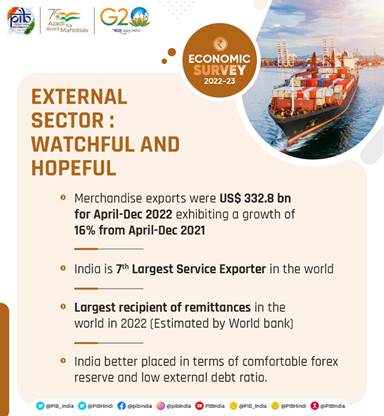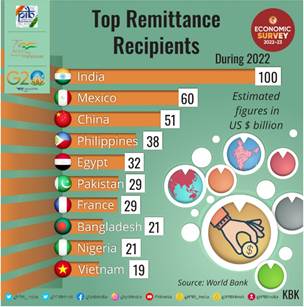Ministry of Finance
INDIA’S EXTERNAL SECTOR DISPLAYS A POSITION OF STRENGTH IN SPITE OF GLOBAL HEADWINDS
INDIA’S EXPORTS SHOW RESILIENCE DURING FY’23 ON THE BACK OF RECORD LEVELS OF EXPORT IN FY’22
INDIA’S OVERALL EXPORT IN APRIL-DECEMBER 2022 EXHIBITED A POSITIVE GROWTH OF 16% IN DOLLAR TERMS OVER THE SAME PERIOD LAST YEAR
VARIOUS EXPORT PROMOTION MEASURES INITIATED TO NURTURE THE INHERENT COMPARATIVE ADVANTAGE OF INDIAN EXPORTS
REVIVAL OF ECONOMIC ACTIVITY CONTRIBUTED TO INCREASE IN INDIAN IMPORTS
CURRENT ACCOUNT DEFICIT EXPECTED TO BE WITHIN SUSTAINABLE LIMITS IN FY’23
RATIO OF EXTERNAL DEBT TO GDP AT COMFORTABLE LEVELS
FOREX RESERVES STOOD AT US$ 562.7 BILLION AT THE END OF DECEMBER’22
प्रविष्टि तिथि:
31 JAN 2023 1:58PM by PIB Delhi
India has been able to face the headwinds to its external sector from a position of strength in the back of strong macro fundamentals and buffers. The Economic Survey 2022-23 presented in Parliament today by the Union Minister for Finance & Corporate Affairs, Smt Nirmala Sitharaman stated that India’s external sector has been struck by shocks and uncertainties. These manifested in terms of elevated though now easing global commodity prices, heightening International financial market volatility, reversal of capital flows, capital depreciation and looming slowdown in global growth and trade.

The Economic Survey highlights that during FY23 (till December 2022) India’s exports displayed resilience on the back of record levels of exports in FY22. Petroleum products, gems & jewellery, organic & inorganic chemicals, drugs & pharmaceuticals were among the leading export items. However, the slowdown in Indian exports is inevitable in a slowing global economy, characterised by slowing global trade. The Survey says that recognising the key role exports play in improving the resilience of the external sector, from a medium to long-term perspective, various export promotion measures are being considered/implemented. These measures would nurture the inherent comparative advantage that Indian exports embody.
The Economic Survey mentioned that National Logistics Policy would ease the domestic frictions to encourage Indian exports by reducing the cost of internal logistics. It also says that the latest Free Trade Agreements, such as with UAE and Australia, would address the external frictions by creating opportunities for exports at concessional tariffs and non-tariff barriers. Thus, the whole ecosystem would evolve in an export-friendly manner over time.
The Economic Survey observes that apart from the elevated crude oil prices, the revival of economic activity contributed to an increase in imports. Petroleum, crude & products; electronic goods; coal, coke & briquettes, etc.; machinery, electrical & non-electrical and gold were among the top import items. It mentions that while continued softening of the global commodity price outlook would assist moderate imports going forward, non-gold, non-oil imports may not decelerate significantly.
The Survey states that India achieved an all-time high annual merchandise export of US$ 422 billion in FY’22. Merchandise export were US$ 332 billion over April-December 2022 against US$ 305 billion during the period April-December 2021. Significant strides in exports were registered in drugs and pharmaceuticals, electronic goods and organic and inorganic chemicals sector in FY’22. India maintained its dominance in world services trade FY’22. India’s services export stood at US$ 254.5 billion in FY’22 recording a growth of 23.5 % over FY’21 and registered a growth 32.7% in April-September 2022 over the same period of previous year. The combined value of goods and services export in April-December 2022 are estimated to be US$ 568.6 billion, showing a growth of 16% compared to April-December 2021.
The Survey highlights that efforts are underway to promote international trade settlement in Indian Rupees. Once these initiatives gain traction, dependence on foreign currency would potentially reduce, making the economy less vulnerable to external shocks. In July 2022, the Reserve Bank of India (RBI) issued a circular permitting an additional arrangement for invoicing, payment, and settlement of exports/imports in Indian Rupees (INR) to promote the growth of global trade with emphasis on exports from India and to support the increasing interest in the global trading community in INR as an international currency. The framework involves invoicing of exports and imports in INR, market-determined exchange rates between the currencies of the trading partner countries, and settlement through special Rupee Vostro accounts opened with authorised dealer banks in India. The Survey states that the framework is significant as this could largely reduce the net demand for foreign exchange and could assist Indian exports in getting advance payments in Indian Rupees from overseas clients. It mentions that in the longer terms this could promote Indian rupees as an International currency once the rupee settlement mechanism gains traction.
On the issue of Balance of Payments (BoP), the Economic Survey says that it encountered pressures during the year under review. While the impact of a sharp rise in oil prices was discernible in the widening of the Current Account Deficit (CAD), notwithstanding the cushion provided by the surplus on Invisibles (services, transfer, and income), policy tightening by the US Federal Reserve and the strengthening of the US dollar led to Foreign Portfolio Investment (FPI) outflows. As a result, the surplus of the capital account was lower than the CAD leading to a depletion of forex reserves on a BoP basis. The Economic Survey expresses optimism that going forward, with the expected easing of crude oil prices, the resilience of net services exports and buoyant inward remittances would result in lower CAD during the remainder of FY23 and is expected to be within sustainable limits. Moreover, a comparison with the position of the current account balance (CAB) for selected countries shows that India’s current account deficit (CAD) is modest and within manageable limits.

According to the Economic Survey, the fortified shock absorbers of India’s external sector are in place to cushion the global headwinds be it the formidable forex reserves, sustainable external debt indicators, or market-determined exchange rate. While forex reserves as of the end December 2022 stood at US$ 562.72 billion, accounting for 9.3 months of imports and the ratio of external debt to GDP is at a comfortable level of 19.2 per cent as of end-September 2022.
In its outlook for the external sector, the Economic Survey states that the export outlook may remain flat in the coming year if global growth does not pick up as indicated by many forecasts. In such cases, diversification of product basket and destination which India is taking through FTAs would be useful to enhance trade opportunities. It also says that given benefit of the lower age of the working population along with the advantages of economies of scale, India has the potential to cater to the global demand for several products in a cost effective manner. The recent softening of global crude oil prices augurs well for India’s POL imports. The survey says that India is cementing its position as the top remittance receiver in the world, with inward remittances projected to be at record levels during 2022. The CAD would be within manageable limits and eminently financeable. The stock of India’s external debt has been prudently managed.
RM/YB/SM
(रिलीज़ आईडी: 1894926)
आगंतुक पटल : 12125